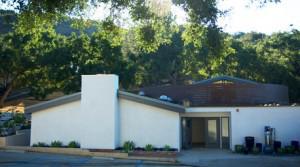 Last month I had the opportunity to visit the MUSE School in Southern California. Located in a canyon between Calabasas and Malibu, the setting for the school is idyllic. Founded in 2006 by Suzy Amis Cameron and her sister Rebecca Amis, this marks the first year on the current campus, a 22 acre spread that formerly housed Cottontail Ranch. Prior to the current location, the school rented facilities while in search of a permanent home. Although only a small portion of the grounds are suitable for building and raising food, the school has dedicated itself to using the land as a primary component for its curriculum.
Last month I had the opportunity to visit the MUSE School in Southern California. Located in a canyon between Calabasas and Malibu, the setting for the school is idyllic. Founded in 2006 by Suzy Amis Cameron and her sister Rebecca Amis, this marks the first year on the current campus, a 22 acre spread that formerly housed Cottontail Ranch. Prior to the current location, the school rented facilities while in search of a permanent home. Although only a small portion of the grounds are suitable for building and raising food, the school has dedicated itself to using the land as a primary component for its curriculum.
As stated on their site, “Sustainability is central to everything we do at MUSE. From our mission statement to our campus design to our daily way of life – we focus on inspiring our students, teachers, staff and community to live sustainably in the classroom, at work and at home, and to become future leaders in preserving and caring for the planet.” Los Angeles based design and consulting firm EcoVations, assisted with the campus renovation. While most schools aim for LEED certification, MUSE School decided to take part in the Living Building Challenge, a stringent set of guidelines for green building that aims for no additional resource consumption beyond what is already in use. Among the school’s goals in the renovations were:
- Diverting 100% of construction waste from landfills.
- Operating with the highest possible energy efficiency
- Constructing zero-net energy buildings that generate as much energy as they consume.
- Constructing zero-emissions buildings that have no carbon footprint.

Food also plays an integral role. The school anticipates growing roughly one-third of the food it consumes on site in its organic garden. Furthermore, the school’s kitchen staff, headed by chef Leslie Joy, work with students to prepare meals. Students rotate through the kitchen and learn about the foods grown on site in conjunction with the garden. Second and third graders were involved in raising chickens, which they watched hatch in the classroom. In addition, goats will be introduced into the curriculum for all grades in the coming months.
MUSE School is planning on producing as much energy as it consumes and being water neutral. The first goal will be aided by the installation of solar panels that will also be used to teach students about math and science. Their water reclamation project looks to replenish the water table and irrigate the gardens with water that falls naturally on the campus.
One of the more unique steps the school took was in its rodent control. When they first came to the campus, it had a rodent problem. Not wanting to use pesticides or poisons, the school’s ground keeper brought in three hawks he had trained to work with owls that lived in the canyon, and cats rescued from a shelter to reduce the rodent population by approximately 95%.
For a more complete list of practices the school engages in, click here.
[Image source]

